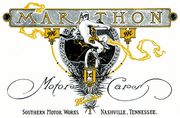.
Marathon Motor Works
Search By Model |
| Defunct |
Marathon Motor Works was an early automobile manufacturer, based in Tennessee. It grew out of an earlier company called Southern Engine and Boiler Works, founded in 1889, which made industrial engines and boilers in Jackson. As such, the firm had metal-working and powerplant experience which could easily be transferred into the then-new and rapidly expanding automobile industry. It turned its attention in this direction shortly after the turn of the twentieth century.
History
Then as now it was common for auto manufacturers to outsource some of their components, concentrating on assembly and marketing, and perhaps manufacture of a few major systems. Southern Engine took a different approach however, and rather audaciously decided to engineer and build every single part of its car inhouse. The company was fortunate to possess an exceptionally talented young engineer, William Henry Collier, who accepted the challenge and by 1906 had a prototype ready for inspection. It was not ready for much else, though, because the company's own newsletter drily remarked that the car "should move, but don't."
Rapid progress was made after that, though, and small production runs were achieved in 1907 and 1908. Outside investors were invited in the latter year, and 1909 saw a two-model lineup, roadster and touring car, powered by 35 HP 4-cylinder engines. Both were open bodies (tops were optional) and sold for about $1500. Sales volume reached about 400 units, a respectable figure at the time especially considering the firm was making virtually all the parts itself.
The vehicles had been marketed as Southerns at first, but another firm was using that name and a decision was made to rebadge the automaking operation and spin it off as a separate company at the same time. In 1910, Marathon Motor Works was created, named out of the enthusiasm for things Greek which had grown out of the 1904 Olympics. At the same time the company moved its operations to a larger facility in Nashville, whose finance and transport infrastructure could better support a growing company.
And grow it did. Marathon was soon on a genuine roll, even by the exuberant standards of the exploding auto industry. The cars acquired a good reputation for quality and durability, probably helped by the fact that the factory had total control of its parts engineering and manufacturing. New models and national advertising followed, and production soared to 10,000 units in 1912. Dealers were signed up literally on every continent and demand considerably exceeded supply.
As with so many of the early auto firms, though, management and finance did not keep up with engineering. It was said that Collier was allowed to make fewer and fewer decisions, having to defer instead to a board of directors that often changed and may have been involved in financial improprieties. Critical personnel began to leave and suppliers began to complain of non-payment. The company fell as fast as it had risen and 1914 was its last year. The tooling was bought by some former staffers with backing from an Indianapolis group and the cars continued to be made briefly in that city by the Herff-Brooks Corporation.
The Marathon is remembered locally as being the only brand of car ever actually built in Nashville. (The present-day Nissan and Saturn facilities in the area are outside the city.) The former Marathon plant still exists and has been renovated into stylish office space. Marathon cars would be very collectible today (like other Brass Era cars), except that practically none seem to have survived. News reports have indicated that there may be only one, in a collection in Argentina, a rather forlorn remnant of the export burst that characterized the company's brief heyday.

